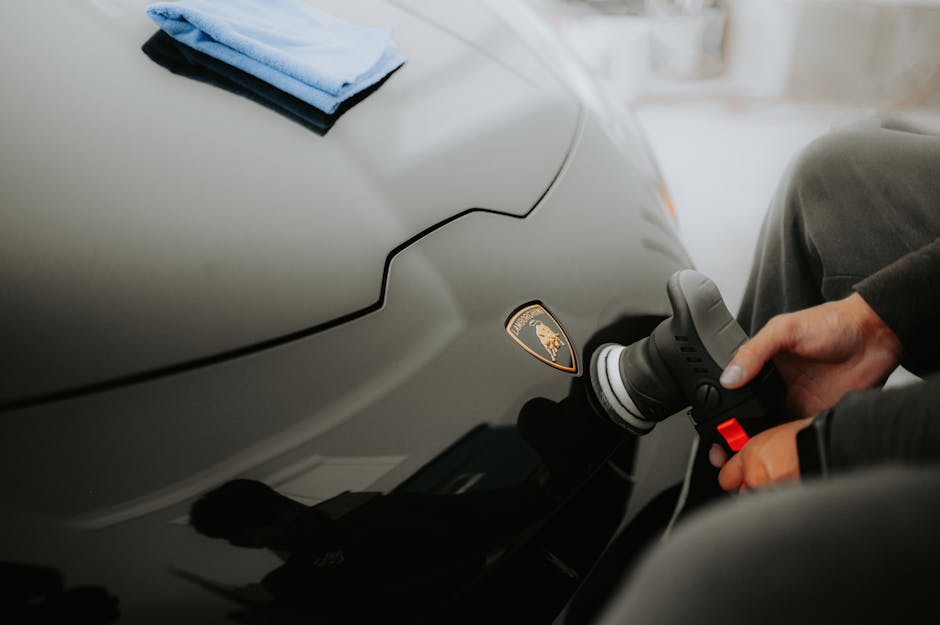Introduction to Paint Correction and Waxing
Paint correction and waxing might sound similar, but they serve very different purposes for your car. Paint correction is a deep cleansing process. It removes flaws from your car’s paint, like scratches, swirl marks, and oxidation, making it look brand new. Consider it a facelift for your car. On the other hand, waxing is like the sunscreen for your paint. It adds a protective layer, making your car shiny and helping keep dirt and grime away. While paint correction fixes existing problems, waxing prevents future ones. Knowing the difference can save you time and money, ensuring your car always looks its best.
What is Paint Correction?
Paint correction is a thorough process aimed at eliminating surface imperfections on a car’s paint, such as swirl marks, scratches, oxidation, and stains. This isn’t just a quick fix. It involves carefully removing a very thin layer of the paint’s surface to make the car look as flawless as possible. Unlike waxing, which only adds a protective layer on top to enhance shine, paint correction actually gets down to the nitty-gritty of the paint. It requires specialized tools and products, such as polishing machines and various grades of compounds and polishes. Also, it demands a skilled hand. Someone who knows how to balance out the paint without causing further damage. In the end, if done correctly, paint correction can significantly improve a vehicle’s appearance and increase its value. It’s not a once-and-done deal, though. To maintain that pristine look, regular care and maintenance are essential.
The Basics of Car Waxing
Car waxing is all about giving your ride a brilliant shine and protective layer. Think of it as sunscreen for your car. It fights off harmful UV rays, dirt, and moisture that can fade and damage the paint over time. Applying wax can be a weekend project. You just need a good quality car wax, a microfiber cloth, and some elbow grease. It doesn’t just make your car look snazzy; it also provides a barrier that can keep paint looking fresh. Typically, car wax comes in three forms: liquid, paste, and spray. Liquid waxes are easy to apply but may not last as long. Paste waxes usually offer a longer-lasting protection but can be a bit harder to work with. Spray waxes are super convenient and great for touch-ups. Remember, waxing isn’t a one-time deal. To keep your car looking its best, you’ll want to reapply wax every few months. It’s an easy way to maintain that glossy finish and protect your car’s paint without needing a deep dive into your wallet.
Key Differences Between Paint Correction and Waxing
Paint correction and waxing both aim to make your car look its best, but they tackle the job in different ways. Paint correction is a detailed process that fixes imperfections in your car’s paint, such as swirl marks, scratches, and oxidation. It often involves sanding down the paint surface and then polishing it to a high shine, removing the blemishes. On the other hand, waxing applies a protective coat on top of the paint. It gives your car a nice gloss, helps protect the paint from dirt and UV rays, but doesn’t fix existing damage. Think of paint correction as healing and rejuvenating your car’s skin, while waxing is like applying sunscreen and makeup on top. If your car’s paint is deeply marred, waxing won’t make those scratches disappear, but paint correction can make your car look new by working on those issues directly. So, in short, paint correction is about fixing, waxing is about protecting.
Why the Difference Matters: The Impact on Your Vehicle
Understanding the difference between paint correction and waxing is crucial because it directly impacts your vehicle’s look, protection, and value. Paint correction is a detailed process that removes imperfections from your car’s paint, like swirl marks, scratches, and oxidation, revealing a flawless finish. This can drastically improve your vehicle’s appearance and increase its resale value. On the other hand, waxing adds a protective layer on top of your car’s paint. It helps guard against UV rays, dirt, and minor scratches, giving your car a shiny, new look. However, waxing does not fix paint imperfections. Choosing the right one depends on your car’s needs. If your goal is to enhance and protect the car’s existing shine without addressing underlying issues, waxing is the way to go. But if you’re aiming for a deeper restoration and correction of paint flaws to elevate your vehicle’s aesthetics and worth, paint correction is the answer. Each serves a unique purpose, and knowing which service your car needs can save you time and money while maintaining your vehicle’s condition and value.
The Benefits of Paint Correction
Paint correction can transform your car’s appearance dramatically. Unlike waxing, which only provides a temporary shine, paint correction removes imperfections from your car’s paint, like swirl marks, scratches, and oxidation. This process not only makes your car look almost brand new but also adds to its resale value. It’s an investment in your vehicle’s aesthetics and durability. With paint correction, your car’s paint gets a new life, making it look vibrant and more resistant to future damage. This means less maintenance over time. Plus, after a paint correction, your car’s coat can better absorb protective sealants or wax, enhancing its protection against environmental damages. Paint correction is the way to go for long-lasting beauty and health of your car’s exterior.
Advantages of Waxing Your Car
Waxing your car isn’t just about making it shine; it’s a practical choice for maintaining the car’s exterior. First off, wax provides a protective barrier against the elements. Sun, rain, dirt, and even bird droppings can damage the paint over time. A good layer of wax helps keep these at bay, reducing the risk of scratches and fading. Plus, waxing makes cleaning your car easier. Dirt and grime will slide right off a well-waxed surface, saving you time and effort. Another benefit is the enhancement of your car’s appearance. Wax brings out the paint’s depth and color, making your vehicle look fresh out of the showroom. Lastly, regular waxing can boost your car’s resale value. A car with a well-maintained exterior is more appealing to buyers, potentially fetching a higher price. So, while it might seem like a chore, waxing your car has several practical benefits that go beyond just aesthetics.
How to Decide: Paint Correction or Waxing?
Deciding between paint correction and waxing boils down to what your car needs and your end goal. Paint correction is your go-to if your car’s paint looks dull, has scratches, or swirl marks. It aims to restore the paint to its original glory, making it look fresh and new. This process involves removing a tiny layer of paint to level out imperfections. It’s more labor-intensive and costs more but the results can last years with proper care. On the other hand, waxing is about protecting the paint and adding a glossy shine. It doesn’t fix scratches but shields against dirt and UV rays. Waxing is quicker, cheaper, and should be done every few months. If you want a quick refresh and protection, wax. If your car’s exterior needs serious rejuvenation, consider paint correction.
Maintenance Tips After Paint Correction and Waxing
After getting paint correction or waxing done on your car, maintaining that showroom shine is key. First off, always wash your car with a pH-neutral shampoo. It’s gentle on the paint and the wax, ensuring your efforts last longer. Secondly, avoid automatic car washes. The brushes can be harsh and might strip away the wax or damage the freshly corrected paint. Instead, opt for hand washing with a soft microfiber cloth or mitt. Make sure to dry your car thoroughly to prevent water spots which can detract from the flawless finish. Also, park your car in the shade as much as possible. Direct sunlight can be tough on your car’s paint and can diminish the wax’s protective qualities over time. Finally, consider applying a spray wax in between your regular waxing sessions. It’ll boost the shine and add an extra layer of protection. Remember, the key to keeping your car looking its best is regular care and using the right products.
Conclusion: Making the Best Choice for Your Car’s Appearance
Deciding between paint correction and waxing boils down to what your car needs and what you aim for its appearance. Paint correction is the go-to for fixing imperfections, offering a long-term solution to revive your car’s showroom shine. It digs deep, eliminating scratches and blemishes but demands more time and a bigger budget. On the flip side, waxing is your quick fix. It’s less about repair and more about protection, adding a soft glow and shielding your car’s paint from everyday wear and tear. Cheaper and faster, waxing works best for regular upkeep. Think of it this way: paint correction is your major renovation, while waxing is your routine maintenance. Each has its place in keeping your car looking its best. Now, armed with the facts, you’re ready to make the best choice for your car’s appearance. Remember, a well-maintained car holds its value better, so consider your decision an investment. Whether it’s the thorough rejuvenation of paint correction or the protective shine from waxing, your car deserves the care that aligns with its needs and your expectations.









